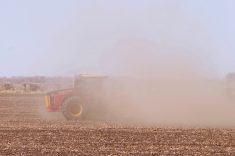Contrary to popular misbelief, financial records can be used for more than just filing income tax. While I think it’s potentially more important to plan than to reflect, one of the most useful things we can do with financial records is to determine the structure of our business operations — and whether we’re on a reasonably productive path.
There are various balance sheet ratios we can look at to assess our businesses, but the income/expense report is really about the operations piece and is where we will focus our efforts in this article.
Gross income
Read Also

In times of mandatory joy, try to find contentment
If we’re not feeling the joy at a time of year that seems to insist on over-the-top moments of happiness, we can allow ourselves to just try for fulfilled or content, farm family coach Kalynn Spain suggests.
Gross income is the total income derived from product sales. For a cow-calf producer this includes calf sales and, importantly, cull marketing. There is no right or wrong gross number, but it’s important to realize it sets an upper theoretical limit on profit.
As a simple example, let’s say our cowherd is a single cow and we sold her calf for $1,000. Our gross income is $1,000. If everything else was free, our maximum theoretical profit is $1,000. We sometimes refer to this as gross product or the value of everything that is produced.
Gross margin
Gross margin (GM) is what we get when we take direct costs from our gross income (GI). Gross margin is the money left over to pay overhead costs and produce profit. I think the best description of direct costs for a cattle operation is anything/everything that goes into or through a cow. This includes feed, vaccine, mineral, ear tags, bull semen et cetera. The rough rule of thumb here is that gross margin should be 65 per cent of gross income.
If we go back to our single-cow herd, the cost of feed, vaccines et cetera is our direct cost (DC). Ideally, this would be less than $350 for the year, leaving us with a 65 per cent gross margin.
$1,000 GI – $350 DC = $650 GM
650 ÷ 1,000 = 65 per cent
A further guideline from Ranching for Profit is that feed should be less than 16 per cent of gross income, or roughly half of your direct costs. With our $1,000 income, that sets our feed bill at $160.
Overhead
Overhead is the “stuff” you use to run cows. This includes chutes, tractors, trucks, shops et cetera. Direct operating costs are the cost of running the “stuff.”
Contribution margin
Contribution margin is when we remove direct operating expenses (DOE) from gross margin. Direct operating costs are line items such as labour and fuel. It does not include capital items like the tractor. Basically, these are operational expenses. A guideline is that they should be 45 per cent of gross margin. In our cow example, our gross margin was $650, so our direct costs should be $293 or less.
$650 GM – $293 DOC = $357 DOE
293 ÷ 650 = 45 per cent
One of the reasons to look at contribution margin is to see if you are efficient and more importantly effective in your efforts. Another ratio I like to look at here is GI per full time equivalent (FTE). Your labour is a large component of cost whether you choose to acknowledge it or not. Where I live in Alberta, the government says I am worth $15 per hour no matter what and I suspect most of us are worth a lot more than that. The other thing to realize is that an FTE does not equal 100 hours a week. The goal here is to produce at least $500,000 of gross revenue per FTE. This can vary a bit if margins are very high or very low, but it is a good target.
Total overhead
The guideline here is that total overhead should be less than 40 per cent of your gross income. “Total overhead” means we lump overhead and direct operating costs together.
If we use our single-cow example, this means we would have $400 worth of overheads total, or $107 for “stuff,” after our direct operating costs.
Currently, it is likely unrealistic that calves are only worth $1,000; however, this number was chosen as it works well for illustrative purposes. It also brings up another important consideration.
Given today’s calf prices, we may be working in a $3,000 per calf environment, but it is unlikely this number is sustainable in the long term. It is important to control our expenses — not just relative to our gross income, but in relation to realistic calf and cull prices moving forward. This is where planning versus reflection kicks in.
Additionally, these ratios may change as we move through various stages of business. Gross revenue per FTE may be lower in a startup, as an example.
For more information, a web search for “farm financial ratios” can provide great further insight.
For your reference
Information for this article was adapted from:
• Standardized Financial Benchmarks for Canadian Farm Financial Statements, by Larry Martin and Joerg Zimmerman















